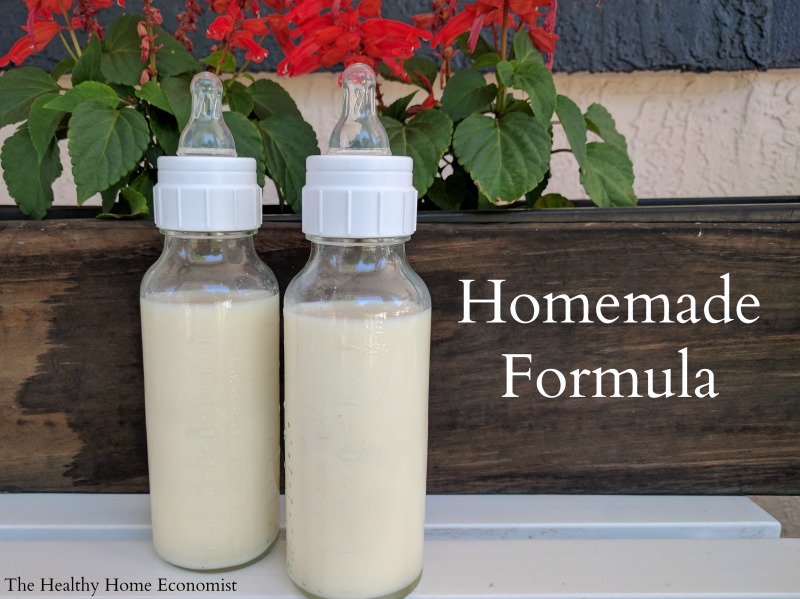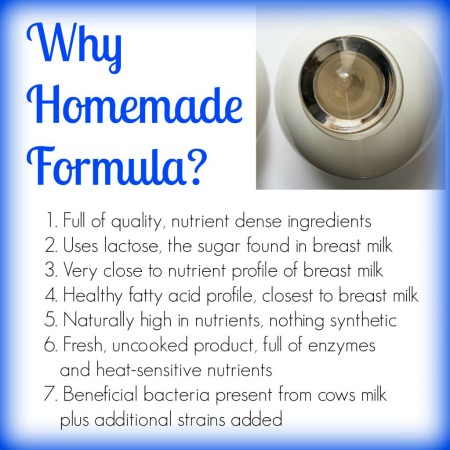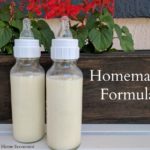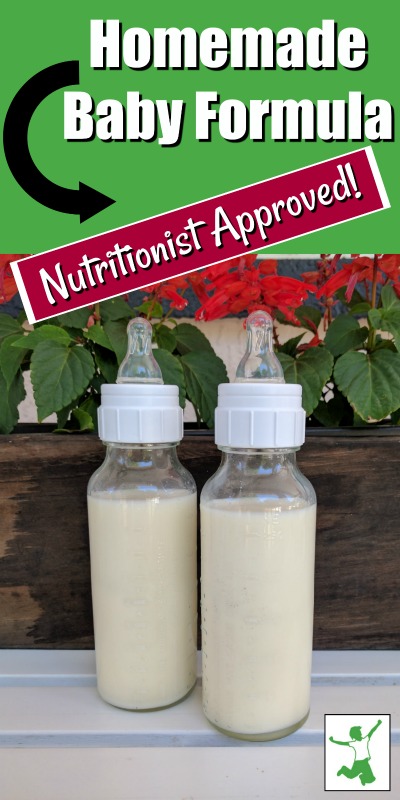Table of Contents[Hide][Show]
A nourishing homemade baby formula using safe, whole ingredients. This recipe was developed and tested by Dr. Mary Enig, a PhD Nutritionist and originally published in Nourishing Traditions cookbook in 1996. It was formulated to match breastmilk as closely as possible and is also suitable for infants. Source: Weston A. Price Foundation

There is no doubt that breastfeeding your baby is the best option for the child’s long-term health and development. Human breastmilk from a well-nourished mother is the perfect food for baby. However, in circumstances where the child is adopted or the Mother finds herself unable to breastfeed, formula feeding becomes necessary. In those cases, homemade baby formula is best.
Using a baby formula recipe that closely matches the nutritional profile of breastmilk is a far better choice than even organic baby formula from the health food store. More on this below.
Note: Donor programs are widely available for human breastmilk. But, the diets of the donor mothers are unknown and most likely nutritionally insufficient. In addition, breastmilk banks pasteurize the donated breastmilk which destroys much of the nutritional benefit. Unless you are fortunate to have a trusted and direct donor milk source in your community, avoid this option!
Dangers of Commercial Formula
Commercial formulas are always a poor choice for a number of reasons. First of all, formula manufacturers line the cans with the chemical BPA. This substance disrupts hormone development and is a probable contributor to early puberty in girls, and ADHD, urogenital abnormalities, and other ills in boys.
The European Food Safety Authority found that canned commercial formula is a significant source of BPA for infants, exposing the child to 13mcg of BPA per kg of body weight per day! BPA-free formula cans are no better. The chemical BPS is typically used instead which is just as dangerous.
Beware that manufacturers pack even organic commercial formula like Earth’s Best in BPA cans. Worse, they use organic brown rice syrup as the primary sweetener which is known to be frequently contaminated with arsenic.
In addition, all commercial milk formulas are processed at extremely high temperatures which violently denature the fragile milk proteins, render them allergenic, and add carcinogens to the final product. Soy infant formula is the worst. Obscenely high processing temperatures not only denature the proteins but large levels of phytic acid in soy block mineral absorption by the infant. Moreover, soy-based plant estrogens disrupt the hormonal development of the baby!
It seems that for the concerned Mother who is unable to breastfeed, learning how to make baby formula at home with safe, pure ingredients is the most prudent way to go!
Why Make Homemade Formula Even if You Are Breastfeeding
In the video below, I show you how to make your own safe, healthy raw milk homemade formula for your baby.
The recipe I follow was originally published in the cookbook Nourishing Traditions in 1996 and developed by Dr. Mary Enig.
Even though I breastfed each of my children for at least 2 years, I made this exact formula for my own children when I was away for the day or the evening as pumping was not an option that worked well for me.
I even used this homemade formula for an entire day once when I had some dental work done and was advised to pump and discard for 24 hours.
As a result, even successfully breastfeeding Moms can use this wonderful homemade formula as a supplement when necessary to their own nutrient-dense breastmilk!
It is advised that even breastfeeding Mothers have the ingredients for this formula on hand for an emergency. If Mom is sick or otherwise unable to nurse, Dad can step in and make this safe alternative until Mom is back on her feet. It takes a few days to a week to gather all the ingredients together to make this formula, which is why I advise having them on hand at all times.
Homemade Most Nutritious
The image below lists the reasons why it is worth it nutritionally to make formula yourself for your precious baby!
You can order all of the required ingredients for the homemade baby formula in one package from this reputable, vetted source.
Moms who have successfully used this formula feeding your children, please post about your experience in the comments section to encourage those who are considering it and need some Mom to Mom encouragement!

Where to Source Quality Milk
The most widely available grass-fed milk around the world is from cows. This is usually the most budget-friendly and easily sourced milk for this recipe for homemade formula.
If only goat milk is available in your area, this recipe for goat milk baby formula can be used instead. When using milk from ewes, please refer to the linked article for an adjusted recipe; one of the benefits of sheep milk is that it is higher in healthy fats than either goat or cow milk.
Camel milk formula is another option that is a particularly digestible form of dairy and growing in popularity around the world.
Alternatively, you can use low temp (vat) pasteurized, non-homogenized whole milk cultured with a piima or kefir starter. Then substitute the piima milk or kefir for the raw milk portion of the formula recipe. Cold-pressed raw milk also must be cultured before using it as it contains no probiotics.
Do NOT use ultrapasteurized (UHT) milk even if organic as it is too highly processed and extremely allergenic!
It is also best to avoid all types of powdered milk for this recipe. The factory process of making milk powder reduces nutrition considerably and denatures it, which makes it more likely baby will have an allergic reaction.
Dairy Allergy Option
If all types of dairy prove unsuitable for your baby, make this nondairy baby formula recipe instead. It uses a base of homemade bone broth as a substitute for milk. It is important not to utilize a plant-based or otherwise vegan baby formula recipe.
Avoid buying bone broth to make the dairy-free formula. Make it yourself! Manufacturers of commercial bone broth, even if authentic, may water down the end product. This is apparent if it does not gel when chilled in the refrigerator.
Many brands have toxic packaging issues as well. If you must buy it in a pinch, see my shopping guide page for vetted brands that are safe.

Homemade Baby Formula Recipe (for infants too)
A nourishing baby formula recipe you can make at home with safe, whole ingredients developed and tested by a PhD nutritionist to match breastmilk as closely as possible. Also suitable for infants.
Ingredients
- 2 cups raw cow milk OR organic whole milk yogurt
- 1 7/8 cups filtered water
- 1/4 cup liquid whey
- 4 Tbl lactose
- 1/4 tsp Bifidobacterium infantis powder
- 2-4 Tbl raw or pasteurized cream
- 1/2 tsp cod liver oil unflavored
- 1/4 tsp butter oil unflavored
- 1 tsp sunflower oil preferably organic
- 1 tsp extra virgin olive oil preferably organic
- 2 tsp virgin coconut oil preferably organic
- 2 tsp nutritional yeast
- 2 tsp gelatin
- 1/4 tsp acerola powder
Instructions
-
Fill a 2 cup Pyrex measuring cup with filtered water and remove 2 TBL (this will give you 1 7/8 cup water).
-
Pour about half the water into a pan and turn burner on medium.
-
Add the gelatin and lactose and let dissolve, stirring occasionally.
-
When gelatin and lactose are dissolved, remove pan from heat and add the rest of the water to cool.
-
Stir in the coconut oil and butter oil until melted.
-
Put remaining ingredients in a glass blender.
-
Add the water mixture and blend for about 3 seconds.
-
Place formula in glass baby bottles or a glass jar and refrigerate.
-
Before giving to baby, warm glass bottle in a pan of hot water or a bottle warmer. NEVER microwave baby bottles!
Recipe Video
Recipe Notes
If using raw cow milk from holstein cows, use 4 Tbl of extra cream (otherwise use 2 Tbl extra cream).
If choosing to make this homemade formula with camel milk, be sure to include 4 Tbl extra cream as camel milk is lower in cream than cow milk.
Do not use high oleic sunflower oil. Use only the brand recommended in the ingredients list which is cold pressed, organic, unrefined, and low oleic.
*Do NOT use powdered whey from the store as it is denatured. Avoid whey from making cheese as it will curdle the formula.
*Do not substitute pasteurized or powdered milk as these are heavily processed, denatured and allergenic foods.
*Do NOT use ultrapasteurized (UHT) cream. It is highly allergenic. Raw or pasteurized cream is acceptable.
*Do NOT use fish oil or krill oil instead of high vitamin cod liver oil as they do not contain any Vitamin D and very little to no Vitamin A.
Collagen powder may be substituted for the gelatin in a pinch (more on peptides in baby formula in this article).
If you are wondering where is the iron in homemade baby formula, this article provides an explanation.
If baby experiences constipation using this formula, try adding 1 tsp of molasses to each batch. This should help move things along.
How to Transition to DIY Formula
Once you’ve viewed the video, gathered the ingredients, and made your first batch, how do you feed it to your baby for the first time?
It is important not to switch all at once as this can cause gas, excessive spit-up, or an uncomfortable change in diaper habits such as constipation or overly loose stools.
Start by giving your baby three-quarters of the old formula blended with one-quarter of the homemade. Try this ratio for a day or two and see how your infant responds.
If no digestive upset or major change in diaper habits occurs, increase the amount to a 50-50 blend of old formula to homemade. Observe for another day or two as before.
If no major issues, increase once again to three-quarters homemade formula to one-quarter old formula. If baby does well on this blend for a third time, you are ready to fully transition to the homemade formula.
At any time during the transition, symptoms of intolerance emerge, back up to the previous successful blend ratio and stay there for a day or two before attempting to increase once again.
Homemade Formula FAQ
Weston Price Foundation
Feeding an Adopted Baby
Traveling Tips with Baby Formula Made at Home
Iron in Baby Formula
Collagen Peptides instead of Gelatin for Homemade Formula?










Hi Sarah,
Would you add 3 cups of raw milk and 1 cup water for extra fat and calories along with all other ingredients minus yeast, and sunflower oil for a 8 1/2 month old baby?
Thank you
The recipe stay exactly the same for an older baby. At one year old, you can switch to plain raw milk assuming the baby is eating an age appropriate amount of solid foods by that time. Please do not make any changes to this recipe! It was put together and researched extensively by the late Dr. Mary Enig to mimic breastmilk as closely as possible.
I am incredibly excited and nervous at the same time. My daughter came to visit with my new grandson. She was nursing exclusively but the baby was not gaining enough weight and was advised to supplement with formula. We tried several kinds of formula and they gave baby terrible gas. While looking for a good formula I was shocked to find corn syrup as the first ingredient. Unbelievable!!! And Unacceptable!!! I’m anxious to know what the Pediatrician will say? Anyone run this by their doctor with good reviews?
Quite honestly, I personally would not mention this to a Pediatrician if it was my baby! You might get your baby taken away and its already happened. I would consult with a holistic practitioner instead.
https://www.thehealthyhomeeconomist.com/state-threatens-to-take-baby-over-homemade-goat-milk-formula/
Used this recipe for our first baby (adopted at 2 days) and are preparing to use it again with our second due in two weeks! We made the recommended change with the nutritional yeast and also made a change with the acerola powder brand. We are so thankful for this recipe. Our son was on half homemade formula and half breast milk (from a very good friend) for 15 months. He is now an incredibly active and healthy 3 year old. Since the glass blender I had with my first broke I’m going to try using and immersion blender this time around as its easier to transport and clean.
Thanks so much for the feedback Sarah, I completely agree, will never give my baby the shop bought formulas and am actually very excited to start making this formula myself. Will need to investigate and try to source a farm close by where we can get some raw cow’s milk from. Another question i have is, how long can you keep this formlula in the fridge before it spoils as well as freeze, is it the same time as breastmilk 5 days in fridge and maximum 6 months frozen, or a little different?
As mentioned in the article, it is best to make this formula fresh every day or every other day. Freezing it is fine for at least a few months. Using ice cube trays or breastmilk bags works great for freezing single portions.
Yes I agree- I was just curious. I nursed my daughter until she was 3 and a half and we are adopting our next child very soon. I figured I’d ask as I wish I was able to give that same nutrition to our next baby. Thank you for your response!
Hi Sarah, I’m in South Africa, A breastfeeding mom for 9 months now and still going strong, just wanted to start inquiring and investigation natural baby formula options as I will not let my babe go onto shop bought formula. Alot of these products are really not easy to come by here in SA, I am also reluctant to use raw cows milk etc, is there not a chance of e coli etc possibly happening. There’s a few people that are against this type of homemade formulas as they say there have been no studies regarding this. Also the proteins in cows milk apparently is too harsh for a baby’s sensitive stytem to break down. Thoughts?
I personally know hundreds of women who have used this formula successfully over the years. The protein in cow milk is EASY for a baby to digest IF IT IS RAW. When you pasteurize milk, that is when the proteins get damaged and are hard to digest/allergenic. Goat milk is another option if you can find a source you are more comfortable with. Here is the recipe for goat milk formula: https://www.thehealthyhomeeconomist.com/goats-milk-formula/
That said, do what you like! I don’t try to convince anyone of anything — I just provide the solid evidence and a recipe and parents can choose for themselves. I personally would be more scared of the commercial formulas at the store with dodgy ingredients! Even the organic ones are very unhealthy choices and have been subject to recalls which killed babies.
Hi Sarah! Love your incredibly informative blog! What about giving babies colostrum? Either from cow, goat, or camel? I know it is so beneficial for babies’ health, I have always wondered how colostrum from a different species would be for a human baby. Thanks!
I don’t have any info on that. Fresh raw colostrum from cows or goats is very hard to come by anyway. I’ve only gotten some once or twice in over 10 years from my local grassfed dairy farmer.
Would I be able to substitute almond or coconut milk if I didn’t want to do dairy? If you feel like some dairy is necessary, could I do almond or coconut milk and then the 2 TBL of cream?
You absolutely CANNOT substitute almond or coconut milk! Doing so greatly risks your baby’s health. If you want to make a non-dairy formula, here is the recipe: https://www.thehealthyhomeeconomist.com/video-hypoallergenic-baby-formula/
HI Sarah, I’m now making this formula for my daughter, my son thrived on it 7-12months once i stopped breastfeeding. Anyway, In the video you say 2 tea spoons of heavy cream and in the ingredients it says, 2 table spoons. Which is it? I think I used to make tablespoons for my son, but want to make sure now.
It’s 2 Tablespoons. Thanks for pointing that out 🙂
I was curious as to how long can you freeze the formula? I see that you stated it can be frozen for emergencies but I am supplementing with this and was hoping to freeze whatever I don’t use on a daily or every two day bases to also then use on a regular bases with hopes of my milk production to increase.
I would suggest 6 months or less.